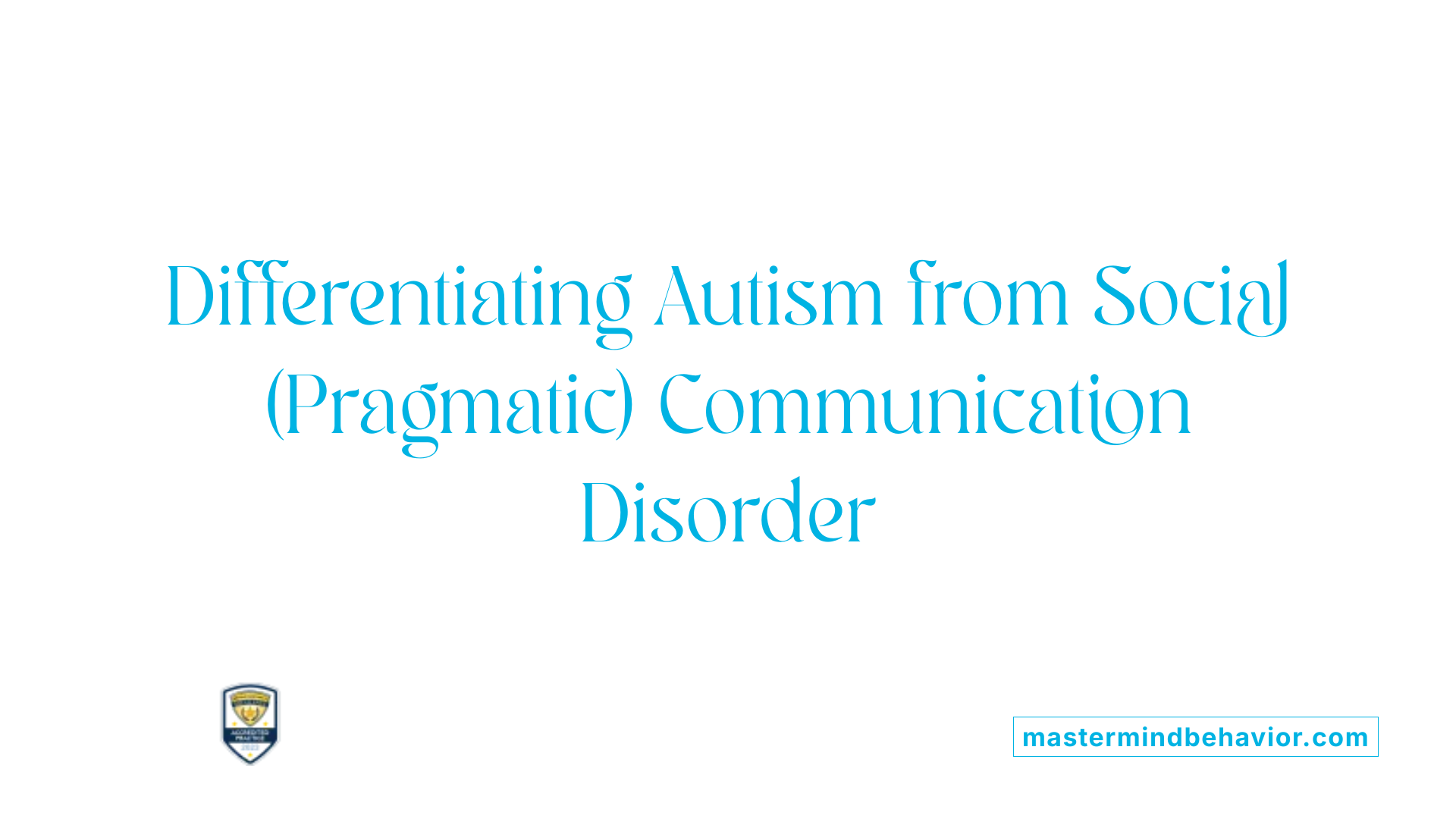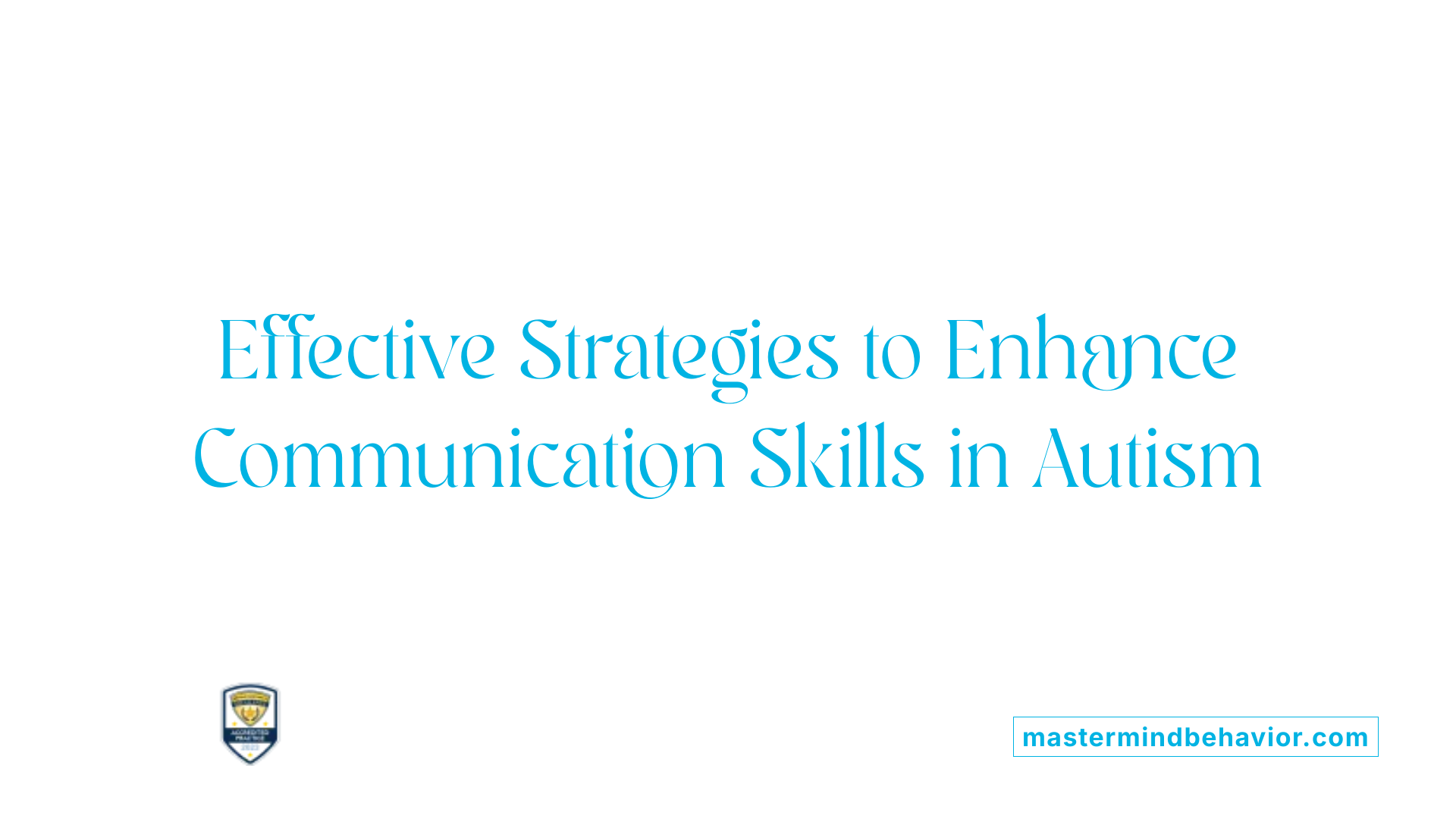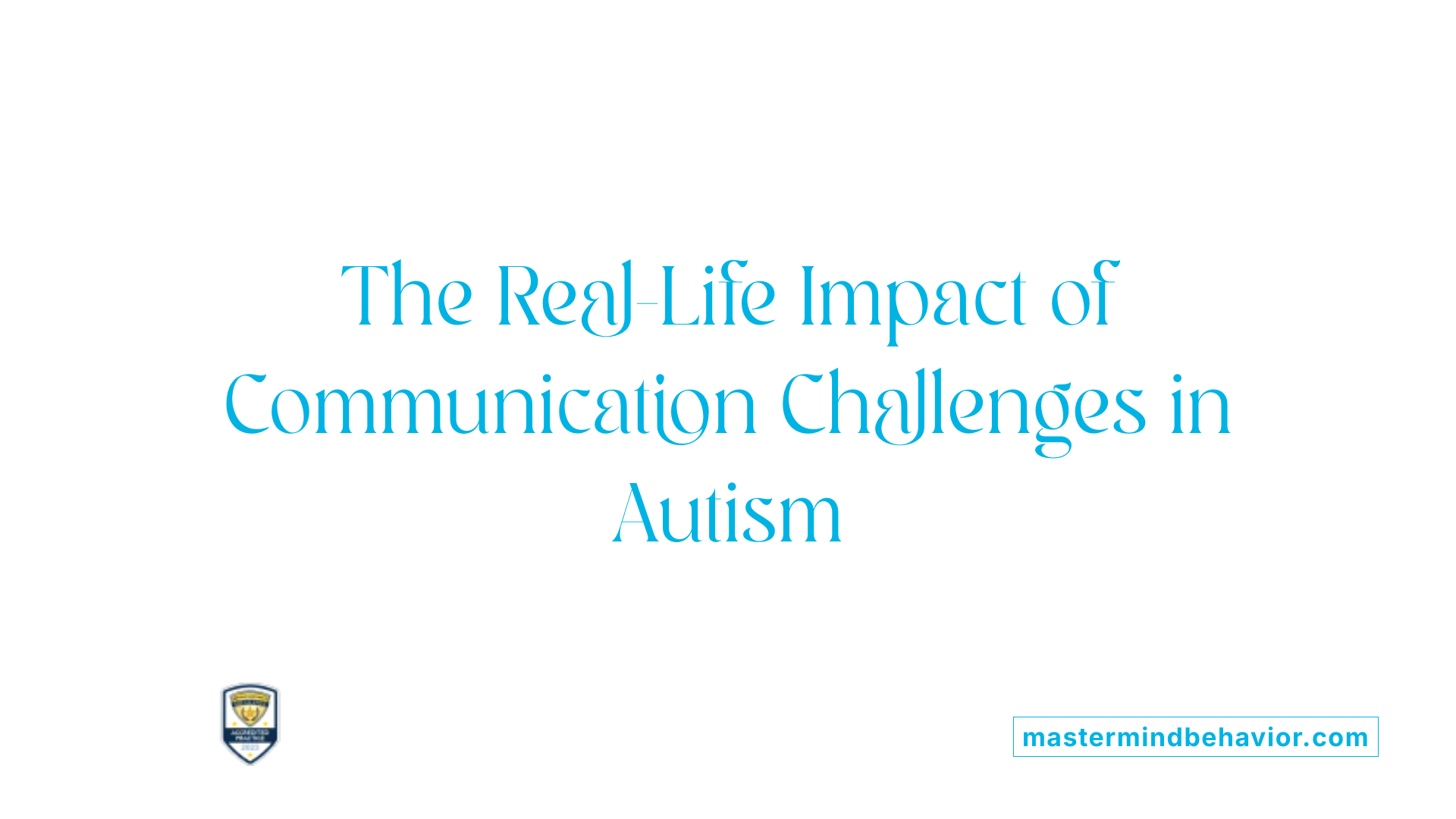Understanding the Link Between Autism and Communication Disorders

Exploring How Autism Influences Communication Skills and Patterns
Autism Spectrum Disorder (ASD) encompasses a wide range of social, behavioral, and communication challenges that vary significantly among individuals. Understanding how autism affects communication skills and the distinctive traits associated with it is vital for fostering better social interactions and improving quality of life. This article delves into the core aspects of communication in autism, distinguishing it from other disorders like Social (Pragmatic) Communication Disorder (SCD), exploring the scientific mechanisms underlying these challenges, and discussing effective strategies for intervention and support.
How Autism Spectrum Disorder Impacts Communication Skills and Patterns
How does autism spectrum disorder affect communication skills and patterns?
Autism spectrum disorder (ASD) plays a significant role in shaping how individuals communicate, both verbally and nonverbally. Children with ASD often face challenges in developing typical communication abilities, which can influence their social interactions throughout life.
One of the earliest signs of communication difficulties in autistic children includes limited eye contact, trouble responding to their names, and reduced use of gestures or facial expressions. This makes it harder for them to engage naturally in conversation or social exchanges.
Repetitive speech patterns like echolalia—repeating words or phrases—are common. Some autistic individuals use very direct, formal language or display rigid linguistic behaviors. Their language development might be uneven, with vocabulary strengths in certain areas but struggles with understanding or social use.
Sensory differences also impact communication. Over or under-sensitivity to sounds, textures, or sights can lead to sensory overload, which may trigger withdrawal or acting out, further complicating interactions.
Many autistic people use alternative communication methods, such as sign language, picture systems, or speech-generating devices, to express themselves when speech is limited or unclear.
Early diagnosis and targeted therapies, including speech-language therapy and the use of AAC (augmentative and alternative communication), are vital. These interventions aim to support both verbal skills and nonverbal cues, helping autistic individuals build more effective communication strategies.
Understanding that communication styles among autistic individuals are diverse and that their differences are not an indication of deficiency is essential. Supporting these differences through tailored approaches can greatly enhance social participation and quality of life.
Traits and Characteristics of Communication in Autistic Individuals

What are common characteristics and traits of communication in individuals with autism?
Autistic people communicate in ways that can be quite different from neurotypical individuals. They often rely less on typical non-verbal cues like eye contact, facial expressions, and gestures, and may instead use alternative methods such as picture exchange systems, sign language, or speech-generating devices.
Many autistic individuals prefer clear, direct, and factual communication. They tend to be honest and straightforward, sometimes discussing their special interests with great passion. This focused sharing can serve as a meaningful social connection for them.
Sensory sensitivities are common, and social settings might feel overwhelming, making structured routines and visual supports helpful in facilitating understanding and interaction. For example, visual schedules or calm spaces can reduce anxiety and improve communication.
Misunderstandings frequently occur because of differing communication styles. Society often expects neurotypical norms, which can lead to misinterpretations of autistic behaviors as lack of interest or disrespect. Recognizing and respecting these differences is crucial.
Supporting autistic communication involves creating inclusive, understanding environments. This may include using visual aids, providing sensory regulation areas, and valuing their unique ways of engaging.
Overall, autistic communication traits are diverse but rooted in authenticity and strength, emphasizing the importance of acceptance and adaptive communication strategies.
Distinction Between Autism and Social (Pragmatic) Communication Disorder

What is the relationship between autism and social (pragmatic) communication disorder (SCD)?
Autism spectrum disorder (ASD) and social (pragmatic) communication disorder (SCD) are related but distinct conditions that impact social communication. Autism includes a range of symptoms such as difficulties with social interaction, communication challenges, and restricted or repetitive behaviors. These signs often appear early in development, like limited eye contact, repetitive behaviors, and special interests.
In contrast, SCD is characterized mainly by struggles with the social use of language. Individuals with SCD have trouble engaging appropriately in social conversations, using gestures, or understanding social cues, but they do not exhibit the repetitive behaviors or restricted interests typical of autism.
While both conditions involve communication difficulties, their underlying features and diagnostic criteria differ. Many social challenges seen in autism overlap with SCD; however, autism involves broader developmental concerns that include behavioral and sensory differences.
Core features and diagnostic criteria
The core of autism involves persistent deficits in social communication and the presence of restricted and repetitive behaviors. These include difficulties in forming peer relationships, understanding social-emotional reciprocity, and engaging in typical play.
SCD, on the other hand, specifically concerns impairments in pragmatic language functions—such as taking turns, staying on topic, adjusting language to the social context, and interpreting nonverbal cues—without the RRBs seen in autism.
Diagnosis of ASD involves observing both social communication impairments and RRBs, often supported by behavioral criteria from the DSM-5. SCD diagnosis requires evidence of social communication challenges, but without RRBs, confirmed through assessments by speech-language pathologists.
Behavioral differences and overlaps
Many behaviors overlap, especially in social interaction difficulties. Both groups may display limited eye contact, trouble understanding body language, or difficulties in conversation.
However, individuals with SCD generally do not show the repetitive behaviors or strong interests associated with autism. Conversely, some children with autism may have language skills that are relatively intact but still struggle with pragmatic language.
Understanding these differences is essential for targeted intervention, as treatments vary depending on the diagnosis.
Developmental timelines
Autism is usually diagnosed early in childhood, often before age 3, based on observable developmental delays in language, social skills, and behaviors.
SCD might not be as evident early on and can be identified later, especially when social challenges become more apparent in school or social settings. The late onset or recognition of SCD is partly due to its focus solely on language use and social pragmatics.
Differential diagnosis process
Diagnosing either condition involves comprehensive evaluation by a multidisciplinary team, including psychologists, speech-language pathologists, and physicians.
In ASD diagnosis, clinicians look for a combination of social deficits and RRBs. For SCD, the focus is strictly on pragmatic language skills—using standardized assessments and observation.
It is critical to distinguish between the two because the treatment approaches differ. For example, SCD interventions may emphasize pragmatic language skills, whereas ASD treatment may include addressing behavioral concerns alongside communication.
Implications for treatment
Both conditions benefit from speech and social skills therapy. For ASD, intervention might also include behavioral therapy, sensory integration, and occupational therapy.
SCD treatments focus primarily on improving functional communication skills within social contexts through targeted speech-language therapy, social skills training, and sometimes visual supports.
Early identification and tailored interventions can improve social participation, academic achievement, and quality of life for individuals with either condition.
| Aspect | Autism Spectrum Disorder | Social Pragmatic Communication Disorder | Differences & Similarities |
|---|---|---|---|
| Core features | Social deficits, RRBs | Pragmatic language deficits | Overlap in social challenges |
| Behavioral signs | Restricted interests, repetitive behaviors | Difficulty in conversational skills, adjusting language | Autism includes broader behavioral patterns |
| Developmental timeline | Early diagnosis, before age 3 | Usually identified later | Timing can vary |
| Diagnosis process | Multiple criteria, behavioral observation | Focused on language use, pragmatic skills | Diagnostic focus differs |
| Treatment approaches | Behavioral, occupational, speech therapy | Focused on language and social skills | Tailored to diagnosis |
Understanding the distinctions between autism and SCD helps improve accurate diagnosis and ensures individuals receive appropriate support, maximizing their social communication and development.
Examples and Spectrum of Communication Issues in Autism
What are examples of communication issues related to autism spectrum disorder?
Communication challenges are central features of autism spectrum disorder (ASD). These issues can manifest in various ways, affecting how individuals interact socially and express themselves.
Many autistic individuals experience verbal delays or limited speech, making it difficult to initiate or maintain conversations. Some might develop language skills at a slower pace compared to their peers or might use very limited spoken language. Others may be non-verbal altogether, relying solely on alternative methods to communicate.
Echolalia, or the repetition of words or phrases heard from others, is common. It can occur immediately or after a delay and may be used strategically by the individual, though it sometimes reflects a lack of functional language use.
Unusual speech patterns, such as monotone voice, singsong intonation, or pedantic and overly formal language, are also observed. These patterns can be linked to difficulties in prosody—intonation, rhythm, and emphasis in speech—which are vital for expressing emotions and understanding social cues.
Beyond verbal communication, many individuals with ASD also depend on non-verbal methods, such as gestures, facial expressions, or body language, which they may find challenging to interpret or use effectively. They might avoid eye contact or use fewer gestures, which can impact social reciprocity.
Some rely on augmentative and alternative communication (AAC) devices, including picture systems, sign language, or speech-generating devices, to support their interaction.
Communication difficulties often lead to misunderstandings in social situations. Others might perceive these behaviors as intentional stubbornness or disinterest, which can affect relationships and social inclusion.
Overall, communication issues in ASD are highly diverse, encompassing delays, atypical speech, non-verbal strategies, and the use of technology, all of which influence social engagement and daily functioning.
Treatment Strategies and Interventions for Improving Communication

What treatment options and strategies can improve communication in autistic individuals?
Enhancing communication skills in autistic individuals requires a personalized mix of proven interventions focused on their unique needs. Speech-language therapy is a cornerstone, helping develop both verbal and non-verbal communication skills. These programs often include social skills training, which encourages appropriate social interactions, and visual supports like picture schedules or cue cards that make communication clearer.
Augmentative and alternative communication (AAC) methods are vital for those who are nonverbal or have limited speech. AAC tools encompass sign language, gestures, communication boards, and electronic devices such as speech-generating tablets. These systems enable individuals to express needs, desires, and thoughts effectively.
Behavioral approaches like Applied Behavior Analysis (ABA) are widely used. ABA focuses on reinforcing positive communication behaviors, teaching functional language skills through structured tasks and rewards. This technique helps improve everyday conversations and social exchanges.
In addition to these, social-relational strategies such as the Developmental, Individual Difference, Relationship-based model (DIR) or social stories help individuals understand social cues, context, and appropriate responses. These approaches foster social cognition and emotional understanding, crucial for meaningful interactions.
A successful intervention combines these methods around the person’s specific strengths and challenges. Incorporating visual supports, AAC tools, structured behavioral programs, and real-world communication practice offers the best chance for improving speech, language, and social skills in autistic individuals. The goal is not only to increase communication ability but also to improve confidence and independence in social settings.
Neurobiological and Scientific Foundations of Autism-related Communication Impairments

What are the scientific theories or mechanisms behind communication impairments in autism?
Communication challenges in autism are rooted in complex neurobiological differences within the brain. Central to these are synaptic dysfunctions, where proteins like neuroligins, neurexins, and SHANK are involved in forming and maintaining synaptic connections. Disruptions in these proteins can lead to abnormal neural circuits that are essential for language development and social interaction.
Altered excitatory-inhibitory balance, particularly involving neurotransmitters like glutamate and GABA, also impacts neural signaling pathways. These neurotransmitter imbalances can impair the brain's ability to process and respond to social and linguistic information effectively.
Structural brain abnormalities are evident through neuroimaging studies. Variations in connectivity patterns in key regions such as the amygdala, prefrontal cortex, and cerebellum are associated with difficulties in processing social cues and language.
Genetic factors significantly influence these neurobiological pathways. Mutations and copy number variations in autism-associated genes, along with epigenetic modifications, can disrupt normal brain development. These genetic influences affect synapse formation, neuronal growth, and neural network function.
Research into neurochemical systems highlights the roles of glutamate and GABA in maintaining neural circuit balance. Imbalances here can impair sensory processing and social communication, contributing to the hallmark deficits seen in autism.
Neuroimaging studies support these theories by revealing differences in brain structure and connectivity. These findings demonstrate that autism-related communication impairments are not solely behavioral but stem from measurable biological differences.
Overall, the scientific understanding of communication difficulties in autism involves interactions among genetic, molecular, and neural network abnormalities. These disruptions interfere with typical language and social processing mechanisms, leading to the unique communication profiles observed in autistic individuals.
Impact of Communication Difficulties on Social and Daily Life

How do communication difficulties impact social interaction and daily functioning of individuals with autism?
Communication challenges are central to the experiences of many individuals with autism spectrum disorder (ASD). These difficulties can include delayed speech development, atypical speech patterns such as echolalia, trouble interpreting nonverbal cues like facial expressions and gestures, and challenges with pragmatic language, which is the social use of communication.
As a result, everyday social interactions often become complex and stressful. Many autistic individuals find it hard to initiate conversations, maintain eye contact, and understand social norms, leading to feelings of social isolation. These obstacles can make it difficult to form and sustain friendships or participate fully in community and educational settings.
In daily life, these communication issues may cause misunderstandings or frustration. For example, difficulty in understanding idioms or sarcasm can lead to misinterpretations, while sensitivity to sensory overload can make social environments overwhelming.
Furthermore, communication impairments can negatively affect educational and employment opportunities. Difficulties in understanding instructions or conveying needs might limit participation or advancement.
These social and daily challenges often contribute to emotional distress, including feelings of loneliness, anxiety, and lower self-esteem. When society lacks adequate understanding and support, individuals with autism may face rejection or social exclusion.
Supporting individuals early with tailored therapies, like speech-language therapy and social skills training, is vital. These interventions aim to develop functional communication, enhance social participation, and improve overall daily living. Recognizing that communication styles vary across the spectrum is essential for fostering inclusive environments that respect differences and facilitate meaningful interactions.
Fostering Understanding and Support for Autism-Related Communication Challenges
Improving our understanding of how autism impacts communication is crucial for developing effective support strategies and reducing social stigma. Recognizing the diversity in communication styles and the strengths that autistic individuals bring to social interactions enables more inclusive environments. With targeted interventions, technological aids, and societal acceptance, autistic individuals can enhance their communication skills and lead fulfilling lives. Bridging the communication gap requires a collective effort that values neurodiversity and promotes mutual understanding, ensuring that everyone’s unique ways of communicating are respected and supported.
References
- Autism Spectrum Disorder: Communication Problems in Children
- Autism and communication - National Autistic Society
- Autism (Autism Spectrum Disorder) - ASHA
- Understanding Social Communication Differences in Autism ...
- Understanding Social Communication Disorder: How it Differs from ...
- Understanding the language and communicative impairments in ...
- Understanding Autism and Communication Difficulties in Adults
- Social (Pragmatic) Communication Disorder | Autism Speaks
Recent articles

Understanding the Link Between Autism and Communication Disorders
Decoding Communication Challenges in Autism Spectrum Disorder

How ABA Therapy Prepares Teens with Autism for Adulthood
Empowering the Future: The Impact of ABA on Autistic Teenagers' Transition to Independence

The Role of ABA Therapy in Building Emotional Regulation Skills
Unlocking Emotional Resilience in Children with Autism

How ABA Therapy Helps with Imitation and Observational Learning
Unlocking Learning Potential in Autism through ABA

The benefits of teaching mindfulness techniques
Transforming Education Through Mindfulness

The Benefits of Sensory Play for Developing Emotional Awareness in Autism
Harnessing Sensory Play to Foster Emotional Growth in Autistic Children



